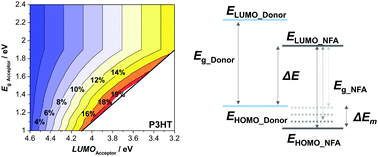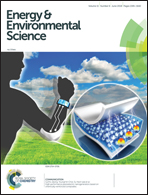Analyzing the efficiency, stability and cost potential for fullerene-free organic photovoltaics in one figure of merit†
Abstract
The power conversion efficiencies (PCEs) of solution-processed organic photovoltaic (OPV) devices continue increasing towards the 15% milestone. Recently-emerging non-fullerene acceptors (NFAs) have significantly accelerated this development. Most of the efficiency analyses performed previously are based on a fullerene acceptor without considering its contribution to the enhancement of photo-absorption and PCE. Moreover, the stability and cost potential of OPV devices are usually not discussed, which sometimes makes the efficiency prediction less representative for broad interest. In this work, we effectively combine the prediction of efficiencies with experimentally determined stability data to analyze and predict the commercial potential of a NFA-based OPV product. Assuming that NFAs dominate the blend near IR absorption, the efficiency limit of OPV devices is predicted to be close to 20% and is found to be insensitive to the donor bandgap. With the excellent photo-stability observed for state-of-the-art NFA-based OPV devices, it is suggested that the corresponding customized donors with promising processing properties, excellent environmental stability and low synthesis complexity be designed as realistic material pairs for large-scale production and commercialization.



 Please wait while we load your content...
Please wait while we load your content...